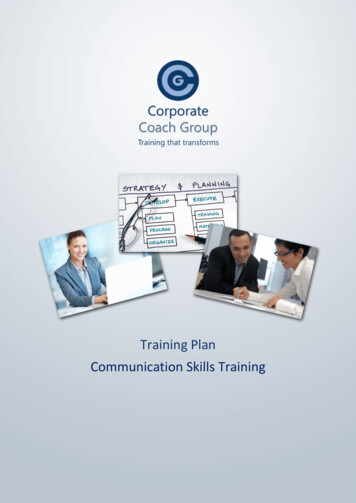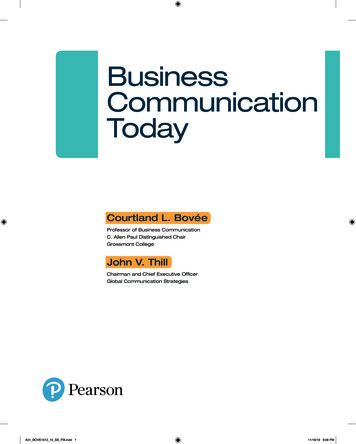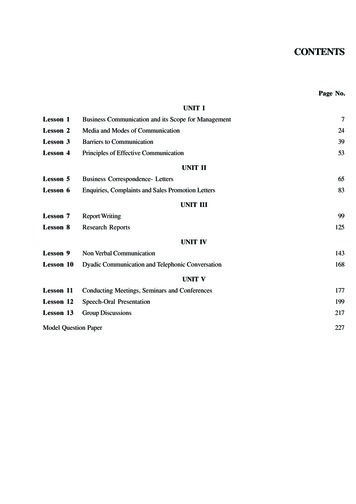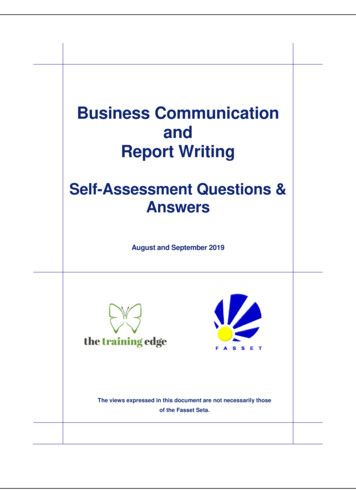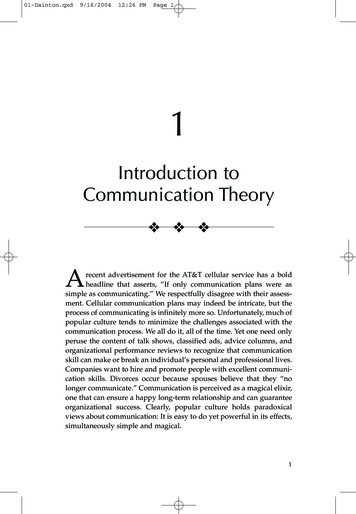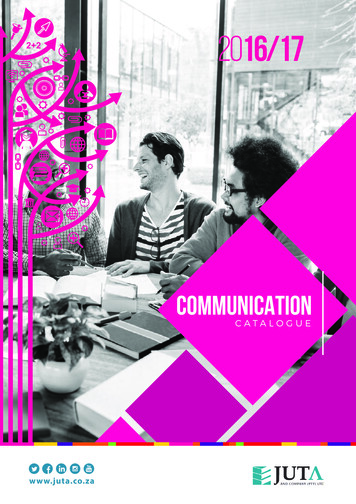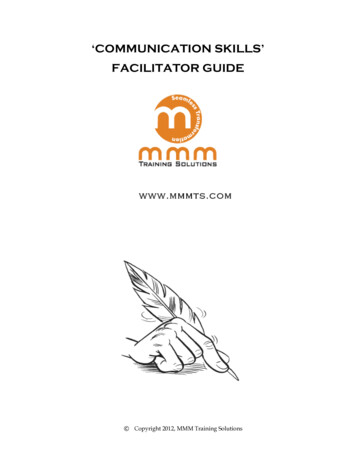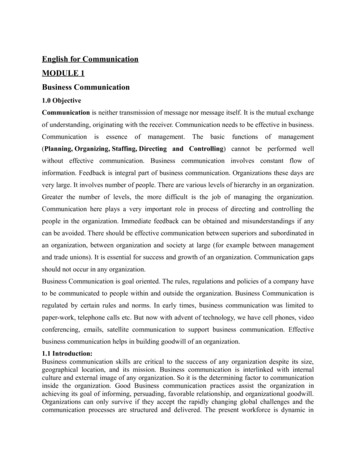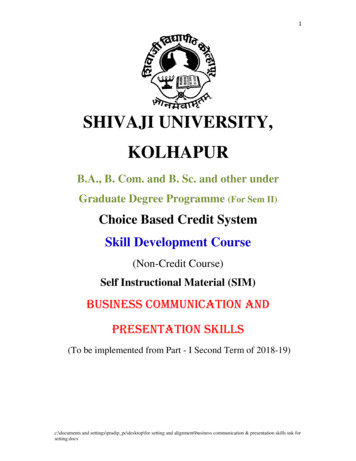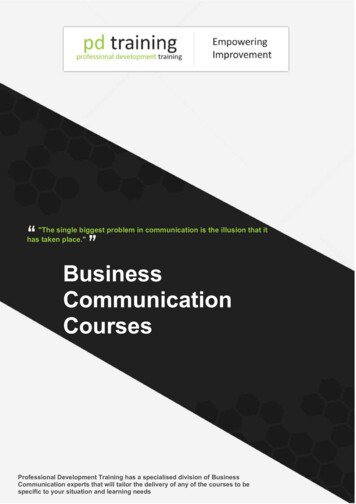
Transcription
"The single biggest problem in communication is the illusion that ithas taken place."BusinessCommunicationCoursesProfessional Development Training has a specialised division of BusinessCommunication experts that will tailor the delivery of any of the courses to bespecific to your situation and learning needs
Business Communication CoursesActive Listening Training-The secret ofgreat communicators!Business Etiquette TrainingCourseBusiness Writing CourseCommunication Skills Training CourseConflict Resolution TrainingCreative Problem SolvingTrainingEmail Etiquette TrainingMeeting Management CourseNegotiation TrainingProfessional Telephone Skills CoursePublic Speaking TrainingEmotional Intelligence (EQ)Writing Winning Proposals TrainingCourseCommunicating Across CulturesTraining CourseBody Language TrainingThink on Your Feet (2-days)Minute-taking Training CourseManaging DifficultConversationsTeam Communication CourseTelework and TelecommutingTrainingDelivering ConstructiveCriticism Training
Learn to Communicate Effectively Across All Levelsof BusinessProfessional Development Training has a specialised division of Business Communicationexperts that will tailor the delivery of any of the courses to be specific to your situation andlearning needs.Our extensive curriculum in Business Communication, outstanding depth of trainers across thecountry and diverse range of industry experience means that pd training is the best choice forBusiness Communication courses.pd training will exceed your expectations and help you achieve the results you are seeking.
Active listening is the key to effective communication.In this Active Listening training course you will learn how to listen, understand and then respond. Using these techniquesyou will become a more effective communicator in all situations.Pd training's active listening training course is available now in Brisbane, Sydney, Melbourne, Adelaide, Canberra,Parramatta and Perth.Active Listening Training-The secret of great communicators! Course OutlineForeword:Effective listening is actively absorbing the information given to you by a speaker, showing that you are listening andinterested and providing feedback to the speaker so that he or she knows the message was received.This fun and interactive Active Listening Skills Training Program will provide practical skills and knowledge that youwill transform your personal and professional interactions and lead to more rewarding and meaningful communication.Outcomes:In this course participants will:Engage more effectively through actively listeningUnderstand the difference between ‘hearing’ and ‘listening’Learn the techniques to listen activelyIncrease their awareness of communication behavioursUnderstand how emotions effect their ability to listenLearn to paraphrase and restate for clarificationBe able to manage and encourage constructive collaboration
Active Listening Training Course - Lesson 1How Well do you Actively Listen?Let's test your active listening abilityWhy are you not listening to me?Our inner voice-over ruleActive Listening Training Course - Lesson 2What affects Listening?The role of the speakerThe role of the listenerReading non-verbal communicationUsing questioning skillsFeedbackActive Listening Training Course - Lesson 3Active Listening Training Course - Lesson 4Determine your Communication BehavioursHigh Emotion - Low IntelligenceEstablish your behavioural style in different situationsSo what does it mean when I become emotional?Do you give up or bulldoze through?How does it affect my listening skills?But isn't your way right?How does it affect the listening skills of others?Active Listening Training Course - Lesson 5Steps to Improve your Active ListeningLearn to live in the momentLearn to like/love/gain respectListening is also interpretingActive Listening Training Course - Lesson 6Tips and Tricks to Manage a Brainstorming EnvironmentStay in controlGenerate better ideas through collaboration
The pd training Business Etiquette training course will align your staff's understanding of professionalism with the desiredexpectations of your company. As participants your staff will conduct themselves more professionally, communicatemore effectively, acquiring the tools to create that all important first impression.Business etiquette training courses are available now throughout Australia, including Brisbane, Sydney, Melbourne,Adelaide, Canberra and Perth.Business Etiquette Training Course Course OutlineForeword:Business etiquette has never been more important. Traditional structures and communication is changing, howeveretiquette and professionalism are still important within the business and with external clients.Outcomes:In this course participants will:Understand what etiquette is and why it's importantLearn how to introduce yourself professionallyUnderstand the "3 C's" and how to use them to create a good first impressionLearn tools to assist and minimise nervousnessUse techniques to master name memorisationKnow the "4 levels of conversation"Learn to conduct yourself professionallyUnderstand appropriate etiquette for open plan and cubicle environmentsKnow what not to do in a meetingAcquire the fundamentals of email etiquette
Business Etiquette Training Course - Lesson 1Networking for SuccessCreating an Effective IntroductionMaking a Great First ImpressionMinimising NervousnessUsing Business Cards EffectivelyRemembering NamesBusiness Etiquette Training Course - Lesson 2Professional IntroductionsThe three-step processThe four levels of conversationThe HandshakeBusiness Etiquette Training Course - Lesson 3Professional Office ConductOpen Plan and Cubicle environmentsWorking out of the officeEating at WorkMeeting Do's and Don'tsBusiness Etiquette Training Course - Lesson 4Business Email EtiquetteProfessionalism & emailsProper and improper use for forwarding and CCGrammar, flaming and netiquetteTop 5 technology tipsBusiness Etiquette Training Course - Lesson 5Business E-Mail EtiquetteAddressing your MessageGrammar and AcronymsTop Five Technology TipsBusiness Etiquette Training Course - Lesson 6Eating OutOrdering in a RestaurantAbout Alcoholic BeveragesPaying the BillTippingBusiness Etiquette Training Course - Lesson 7Telephone EtiquetteDeveloping an Appropriate GreetingDealing with Voice MailMobile Phone Do's and Dont'sBusiness Etiquette Training Course - Lesson 8The Written LetterThank You NotesFormal LettersInformal LettersBusiness Etiquette Training Course - Lesson 9Dressing for SuccessThe Meaning of ColoursInterpreting Common Dress CodesDeciding what to WearBusiness Etiquette Training Course - Lesson 10International EtiquetteGeneral RulesImportant PointsPreparation Tips
This Professional Business Writing Training Course provides participants with techniques to structure a diverse range ofbusiness documents for greater clarity and impact.This Business Writing Course will benefit people at all levels across the organisation. This course has a strong focus onwriting effective email and other business documents for better readability ensuring messages are communicatedconcisely and clearly.Professional Business Writing training is great for all staff and more fun than you think, so join a class today or have atrainer come to your workplace in Brisbane, Sydney, Parramatta, Melbourne, Canberra, Adelaide or Perth.Business Writing Course Course OutlineForeword:Writing is a key method of communication in personal and professional life and for many it is a skill that requires focus,training and practice. In this Professional Business Writing Training Course participants will refresh some fundamentalssuch as spelling, grammar, and punctuation.People will also learn how to approach most common business documents including emails, proposals, reports andagendas providing that extra level of professionalism with internal and external communications.Outcomes:In this course participants will:Gain a better understanding of common spelling & grammar issues in business writingReview basic concepts in sentence & paragraph constructionLearn to use email professionally & effectivelyLearn how to write agendas, email messages and business lettersUnderstand the key elements of a great written proposalMaster techniques for improved proofreading skillsLearn how peer reviews can help improve business writing skillsGain an understanding of printing and publishing guidelines
Business Writing Training Course - Lesson 1Writing with Professional ImpactSpellingGrammarCreating a Cheat SheetBusiness Writing Training Course - Lesson 2Structuring Sentences for Effectiveness andReadabilityParts of a SentencePunctuationTypes of SentencesBusiness Writing Training Course - Lesson 3Creating Paragraphs with Persuasive PowerThe Basic PartsOrganisation MethodsBusiness Writing Training Course - Lesson 4Writing Meeting AgendasThe Basic StructureChoosing a FormatWriting the AgendaBusiness Writing Training Course - Lesson 5Professional Email and Email EtiquetteAddressing Your MessageAppropriate and effective use of 'Urgent'Make the most of your prime email-estateIntroduction – Body – ConclusionEffective Subject lines: Don’t make me open the email to findout the purposeDon’t make me scroll! - 1 page view onlyDon’t make me translate your sloppy languageDon’t make me read redundant words2 – 3 lines per paragraphSalutationSignoff and SignatureCorporate Communications TaglinesUsing 'Draft'Using 'Time Delays'Grammar and AcronymsEmail StyleChoosing a StyleWriting the EmailBusiness Writing Training Course - Lesson 6Writing Business LettersThe Basic StructureChoosing a FormatWriting the LetterBusiness Writing Training Course - Lesson 7Writing ProposalsThe Basic StructureThe key elements to a great proposalWhat to leave outBusiness Writing Training Course - Lesson 8Writing ReportsThe Basic StructureThe key elements to a reportUsing Tables Graphs and ImageryCommon mistakesBusiness Writing Training Course - Lesson 9Other Types of DocumentsRequests for ProposalsProjectionsExecutive SummariesBusiness CasesBusiness Writing Training Course - Lesson 10Proofreading and Finishing - Avoid the CringeA Proofreading PrimerHow Peer Review can helpPrinting and Publishing
The ability to communicate effectively can have a profound effect on your personal and professional life.This communication skills training course provides you with practical, effective tools to enable clear and effectivecommunication in all situations.This engaging and highly practical training course is available now throughout Australia, including Brisbane, Sydney,Melbourne, Adelaide, Canberra, Parramatta and Perth.Communication Skills Training Course Course OutlineForeword:This communications training course helps people communicate appropriately and clearly in all situations. This is a greatcourse for everyone as the benefits can have a positive effect on every aspect of life. Learn to understand how youcommunicate, how others communicate and how to adjust to meet their needs. Discover how effective communication isgreatly improved by understanding communication preferences and overcoming communication barriers.This interpersonal communication course will ensure your colleagues receive your message clearly and improve yourworkplace relationships in general. If you have never completed a communications course of this type you are missingout on understanding fundamental concepts that will have a profound effect on your life and success in the workplace.Outcomes:In this course, participants will:Gain insight into their personality type and communication preferences, using our proprietary profiling toolLearn to recognise other people's personality types and communication preferencesLearn to adjust your own communication approach based on need and situationUnderstand barriers to effective communication and how to overcome themLearn how to effectively utilise toneMaster the S.T.A.R. method for speaking on the spotLearn to use body language appropriatelyLearn to listen actively and effectivelyGain insight into asking open questionsBecome a more effective communicator through the use and application of practical tools
Communication Skills Training Course - Lesson 1Getting to know yourself - CHOIceWhat is your personality type?What are your communication preferences?What are your communication tendencies?Communication Skills Training Course - Lesson 2Understanding others - CHOIceWhat other personality types are out there?What are their communication preferences?What are their communication tendencies?Communication Skills Training Course - Lesson 3Communication Skills Training Course - Lesson 4Making allowance for others CHOIce and circumstance Understanding Communication BarriersConsider your approach:An Overview of Common BarriersWhat is the receiver's CHOIce?Language BarriersWhat type of message are you delivering?Cultural BarriersIs sensitivity, personal touch, speed,Differences in Time and Placeevidence, privacy or publicacknowledgement most important?Develop strategies for future applicationCommunication Skills Training Course - Lesson 5Paraverbal Communication SkillsThe Power of PitchThe Truth about ToneThe Strength of SpeedCommunication Skills Training Course - Lesson 6Non-Verbal CommunicationUnderstanding the Mehrabian StudyAll About Body LanguageInterpreting GesturesCommunication Skills Training Course - Lesson 7Speaking Like a S.T.A.R.S SituationT TaskA ActionR ResultSummaryCommunication Skills Training Course - Lesson 8Active Listening SkillsSeven Ways to Listen Better TodayUnderstanding Active ListeningSending Good Signals to OthersCommunication Skills Training Course - Lesson 9Asking Good QuestionsOpen QuestionsClosed QuestionsProbing QuestionsCommunication Skills Training Course - Lesson 10Appreciative InquiryThe Purpose of AIThe Four StagesExamples and Case StudiesCommunication Skills Training Course - Lesson 11Mastering the Art of ConversationLevel One: Discussing General TopicsLevel Two: Sharing Ideas and PerspectivesLevel Three: Sharing Personal ExperiencesOur Top Networking TipsCommunication Skills Training Course - Lesson 12Conversational PsychologyUnderstanding Precipitating FactorsEstablishing Common GroundUsing “I” Messages
Conflict in human relationships, even good relationships, is inevitable. Learning how to manage conflict is a key skill foranyone that works in a team, interfaces with customers or has a supervisory role.This Conflict Resolution Training Course empowers participants with the techniques to identify the source of conflict andto manage and resolve conflict quickly with professionalism.Join a Conflict Resolution Training Class today, or have a trainer come to your workplace in Brisbane, Sydney,Parramatta, Melbourne, Canberra, Adelaide or Perth.Conflict Resolution Training Course OutlineForeword:Conflict is the result of people having differing needs, opinions, expectations and importantly different perspectives.The reality of conflict is that in any human relationship it is inevitable, if handled well, conflict provides a powerful avenuefor significant growth.Conflict resolution involves recognising and managing the particular conflict. This is an essential part of buildingemotional intelligence, and nurturing relationships. Poorly handled conflict can affect both the employees and the clientsthereby impacting the company’s bottom-line. To maintain your competitive advantage, you need the entire organisationto focus on developing conflict resolution strategies to quickly and effectively resolve conflict, while building trust andcommitment with clients and colleagues.This Conflict Resolution Training Course provides techniques for individuals in an organisation to resolve workplaceconflict and build a common understanding and framework for working through challenging conflict situations. We have,after much research, decided to focus on the Win-Win Approach using the three critical skills of conflict resolution –Negotiation, Assertiveness and Persuasion. These skills will enable the participants to develop conflict resolutionstrategies for quickly and effectively recognising, resolving and preventing conflict.Outcomes:In this course participants will:Gain a thorough understanding of the sources, causes and types of conflictMaster all six phases of the conflict resolution processUnderstand the five main approaches to conflict resolutionLearn to apply conflict resolution approachesLearn how to use parts of the conflict resolution process to recognise and prevent conflict before it escalatesDevelop communication tools such as agreement frames and open questionsLearn practical anger and stress management techniques
Conflict Resolution Training Course - Lesson 1An Introduction to Conflict ResolutionWhat is Conflict?What is Conflict Resolution?Understanding the Conflict Resolution ProcessConflict Resolution Training Course - Lesson 2Conflict Resolution with the romisingAccommodatingAvoidingConflict Resolution Training Course - Lesson 3Creating an Effective AtmosphereNeutralising EmotionsSetting Ground RulesChoosing the Time and PlaceConflict Resolution Training Course - Lesson 4Creating Mutual UnderstandingWhat do I Want?What do They Want?What do We Want?Conflict Resolution Training Course - Lesson 5Focusing on Individual NeedsFinding Common GroundBuilding Positive Energy and GoodwillStrengthening your PartnershipConflict Resolution Training Course - Lesson 6Getting to the Root CauseExamining Root CauseCreating a Cause and Effect DiagramThe Importance of ForgivenessIdentifying the Benefits of ResolutionConflict Resolution Training Course - Lesson 7Generating OptionsGenerate, don't EvaluateCreating Mutual Gain Options and Multiple OptionSolutionsDigging Deeper into your OptionsConflict Resolution Training Course - Lesson 8Building a SolutionCreating CriteriaCreating a ShortlistChoosing a SolutionBuilding a PlanConflict Resolution Training Course - Lesson 9The Short Version of the ProcessEvaluating the SituationChoosing your StepsCreating an Action PlanUsing Individual Process StepsConflict Resolution Training Course - Lesson 10Additional ToolsStress and Anger Management TechniquesThe Agreement FrameAsking Open Questions
"Learn to become part of the solution."This Creative Problem Solving training course will provide participants with a complete and practical understanding of thesteps involved to analyse, discover and solve problems in the workplace.Join a Creative Problem Solving training class today, or have a trainer come to your workplace in Brisbane, Sydney,Parramatta, Melbourne, Canberra, Adelaide or Perth.Creative Problem Solving Training Course OutlineForeword:In the past few decades, psychologists and business people alike have discovered that successful problem solvers tendto use the same type of process to identify and implement the solutions to their problems. This process works for anykind of problem, large or small.This Creative Problem Solving workshop will give participants an overview of the entire creative problem solving process,as well as key problem solving tools that they can use every day.Outcomes:In this course participants will:Understand the complete process of creatively solving a problem.Learn some key questions to ask when gathering information about a problemTake home tools to effectively determine what 'the problem is'Learn to write concrete problem statementsDiscover idea-generating tools like affinity diagrams, word chaining, the box method, the six thinking hats & the blinkmethodLearn to evaluate potential solutions against specific criteria like a cost/benefit analysis or group votingLearn to perform a final problem analysis and then select a solutionUnderstand the why's & how's of refining & re-refining a solution shortlistLearn how to identify the tasks & resources necessary to implement a solutionUnderstand how to evaluate & adapt solutions to reality
Creative Problem Solving Training Course - Lesson 1The Problem-Solving MethodIntroduction to Six-Step ProcessProblem DefinitionInformation GatheringGenerating Possible SolutionsAnalysing the SolutionsSelecting the Best Solution(s)Planning the Next Course of ActionCreative Problem Solving Training Course - Lesson 2Problem DefinitionIdentifying the ProblemPAG vs. PAUDetermining the ScopeWriting the Problem StatementCreative Problem Solving Training Course - Lesson 3Information GatheringUnderstanding Types of InformationIdentifying Key QuestionsDeveloping CriteriaCreative Problem Solving Training Course - Lesson 4Brainstorming BasicsCreating a Creative SpaceSetting the Ground RulesGenerating IdeasCreative Problem Solving Training Course - Lesson 6Generating Solutions - Part TwoUsing the Box MethodUsing the Six Thinking HatsUsing the Blink MethodCreative Problem Solving Training Course - Lesson 5Generating Solutions - Part OneLogistical SolutionsUsing Affinity DiagramsWord ChainingCreative Problem Solving Training Course - Lesson 7Evaluating SolutionsDeveloping CriteriaUsing Cost/Benefit AnalysisGroup VotingCreative Problem Solving Training Course - Lesson 8Selecting a SolutionDoing a Final AnalysisFacts vs. IntuitionRefining and Re-Refining the ShortlistCreative Problem Solving Training Course - Lesson 9Planning your Next StepsIdentifying TasksIdentifying ResourcesEvaluating and AdaptingCreative Problem Solving Training Course - Lesson 10Recording Lessons LearnedPlanning the Follow-up MeetingsCelebrating SuccessesIdentifying Improvements
In this age of technology, email is the preferred and often most efficient form of communication, yet many organisationsoverlook this very important form of business communication.This Email Etiquette training course from pdtraining, provides participants with the skills and techniques necessary formanaging emails and writing professionally with effective email structures.This exciting training course is available now throughout Australia, including Brisbane, Sydney, Melbourne, Adelaide,Canberra and Perth.Email Etiquette Training Course OutlineForeword:A new international workplace survey (2007) has found that 83% of Australians use email, Internet, or both while at workand most are convinced it makes them more productive.The survey by global recruitment agency, Kelly Services, found that the use of online communications has extendedacross most of the workforce with only 9% using neither email nor Internet. Both men and women were equallyenthusiastic users of email and the Internet and those in the 25-54 year old age bracket were intensive users.The survey highlights the pervasive use of online tools in the workplace and there is little doubt that online technologieshave transformed the way business operates. With this growing trend in modern business communication withinAustralia, the explosion of unnecessary and time-wasting emails was one of the biggest sources of complaint. Some 35%of workers said they received high levels of emails that were either time wasting or unnecessary. This evidently points tothe volume of emails that are directed to people without a clear purpose.There was widespread acceptance that the technology has a positive impact on the quality of work. However, like anytool, it is important that managers take time to provide the training and support to enable staff to effectively integrateonline tools into their daily work routine, and gain maximum benefit.In an increasingly knowledge-based economy, it is critical that information is widely accessible and able to be utilisedeffectively in the workplace. It is also vital that organisations develop policies to guide employees on the correct use ofonline communications. These should cover issues such as privacy, personal use, monitoring, downloading of content,access by third parties and illegal use of the Internet.An international workplace survey (2007) has found that 83% of Australians use email, Internet, or both while at work andmost are convinced it makes them more productive.The survey by global recruitment agency, Kelly Services, found that the use of online communications has extendedacross most of the workforce with only 9% using neither email nor Internet. Both men and women were equallyenthusiastic users of email and the Internet and those in the 25-54 year old age bracket were intensive users.The survey highlights the pervasive use of online tools in the workplace and there is little doubt that online technologieshave transformed the way business operates. With this growing trend in modern business communication withinAustralia, the explosion of unnecessary and time-wasting emails was one of the biggest sources of complaint. Some 35%of workers said they received high levels of emails that were either time wasting or unnecessary. This evidently points tothe volume of emails that are directed to people without a clear purpose.There was widespread acceptance that the technology has a positive impact on the quality of work. However, like anytool, it is important that managers take time to provide the training and support to enable staff to effectively integrateonline tools into their daily work routine, and gain maximum benefit.In an increasingly knowledge-based economy, it is critical that information is widely accessible and able to be utilisedeffectively in the workplace. It is also vital that organisations develop policies to guide employees on the correct use ofonline communications. These should cover issues such as privacy, personal use, monitoring, downloading of content,access by third parties and illegal use of the Internet.Outcomes:Develop a heightened awareness of the potential perils of digital communicationMaster effective email structures to achieve clarity and successful communicationLearn to write for the reader, starting with effective subject linesMake the most of 'email estate'Carefully consider the email recipientsLearn to work within principles or 'rules of thumb' to ensure professional, clear & effective emailsPerfect grammar because it mattersFormat messages for readabilityLearn to write professionally and brand Broadcast emailsLearn to avoid senders regret by proof readingUnderstand 'netiquette'Master the inbox using some core principles and email functions
Email Etiquette Training Course - Lesson 1IntroductionEvaluate your Email usageWorkshop ObjectivesEmail Etiquette Training Course - Lesson 2Introduction to Email EtiquetteEmail is never secureBig brother may be reading over your electronic shoulderProductivity is lost when cyber-slackers log onEmail misuse and abuse may get you firedEmail can be embarrassingEmail abuse impacts revenues and also reputationsEmail is easily misinterpretedEmail Etiquette Training Course - Lesson 3Create Structure for SuccessForward-To-CC-BCCUrgent! High Importance Low ImportanceSubjectSalutationIntroduction – Body – ConclusionSignatureDraftTime DelaysEmail Etiquette Training Course - Lesson 4Rules of ThumbEffective Subject lines: Tell me up front what you want fromme1 page view onlyAverage 15 words per sentenceAs short as possible – no extra words2 – 3 lines per paragraphEmail Etiquette Training Course - Lesson 5Grammar PerfectUsing spellcheckerCheck for simple sentencesUse the Active VoiceUse of punctuationUse of emoticonsUse of text talkEmail Etiquette Training Course - Lesson 6Formatting your Email MessageEmail StyleWriting the EmailSelecting your format settingsChoose the Right FontSelect Appropriate ColoursEnhancing ReadabilityResist the urge to use All Upper – or Lowercase LettersArranging Text into Vertical ListsSending Attachments with CareEmail Etiquette Training Course - Lesson 7Broadcast EmailsBrandingImportance of Branding and consistent subjectheadingsEmail Etiquette Training Course - Lesson 8Proofreading Does PayA Proofreading PrimerHow Peer Review Can HelpEmail Etiquette Training Course - Lesson 9Polishing Your CybermannersWatch your CyberlanguageAvoiding Sexist LanguageSet the Right ToneDodging Conversational PitfallsExtinguishing FlamesEmail Etiquette Training Course - Lesson 10Netiquette GuidelinesReviewing Netiquette GuidelinesNetiquette Guidelines for ManagersEmail Etiquette Training Course - Lesson 11Managing Email OverloadControlling your Inbox ClutterEmail Etiquette Training Course - Lesson 12ExamplesThe GoodThe BadThe Ugly
Australian businesses spend 19bn per year on meetings and most meeting attendees spend their time daydreamingand even snoozing.Learn how to gain accountability, manage the participants, handle disruptions and ensure outcomes and follow-throughwith this Meeting Management course from pdtraining.This effective training course is available now in Brisbane, Sydney, Parramatta, Melbourne, Adelaide, Canberra andPerth.Meeting Management Course Course OutlineForeword:An Australian University study has shown that companies are wasting huge amounts of money on inefficient meetings.The study conducted by the University of South Australia discovered that one in three workers admitted to falling asleepin meetings while 87% said they daydream and 26% said they did other work.Professor Terry Robbins-Jones, head of the University's School of Accounting and Information Systems says face-toface meetings are costing Australian businesses a whopping A 19bn a year. "People spend well over 50% of their timeworking with other people - making it the single most expensive activity in the business world - and yet we know nothingabout it," he said."Bearing in mind that collaboration - including the time spent in face-to-face meetings - probably accounts for well overhalf the total costs of any organisation, companies should be thinking about having a budget for it or monitoring howeffectively it operates," he added. The University of South Australia study found that 46% of executives felt meetingswere a good use of time, while 33% felt that - at best - they were fairly productive. These figures suggest t
Paraverbal Communication Skills The Power of Pitch The Truth about Tone The Strength of Speed Communication Skills Training Course - Lesson 6 Non-Verbal Communication Understanding the Mehrabian Study All About Body Language Interpreting Gestures Communication Skills

